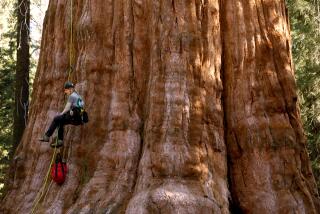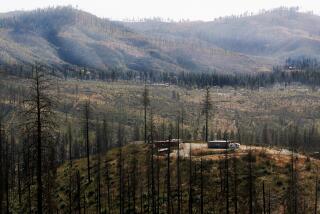Always grand standing
Stand before a fall display of quaking aspens in hushed bewilderment and you want to know them better. Approach an aspen trunk and you don’t know whether to stroke its ivory skin in reverence or avert your eyes out of respect. Lean closer. The parchment-thin bark is not white but greenish, because it contains chlorophyll and photosynthesizes as actively as a giant leaf.
Aspens also bewilder scientists. Although the trees produce seeds that germinate by the millions each summer, the seedlings die quickly in the dry heat. Still, the aspen persists as North America’s most widespread tree -- stretching from Alaska to Mexico -- by cloning itself.
Reaching out with roots that turn upward and grow, a single aspen replicates itself again and again until it may form a stand that can sprawl over several hundred acres and contain more than 47,000 stems.
Visit the June Lake Loop off Highway 395 south of the tiny town of Lee Vining, and elsewhere in the eastern Sierra Nevada this month, and you’ll notice distinct patches of fiery red, orange and yellow. Some of these stands, or clones, consist purely of tall, straight trunks and others solely of short, gnarly ones.
The aspen clones shatter our cultural tendency to delineate either “individual” or “type.” What we view as trees are actually outgrowths of giant parent root systems massive enough to blanket entire hillsides with their nearly identical trunks. And each aspen is its own sprawling network of roots that send up leaf-bearing branches to feed on sunlight energy. Even when conifer forests crowd out the aspen, its root system survives, waiting for forest fires or avalanches to free space where stems can spring back to life.
The aspen challenges our concepts of life and death. Because the cool, wet summers that would allow its seeds to thrive have not existed in the American West for at least 10,000 years, many scientists consider the tree an Ice Age relic.
With no known limitation on its cloning mechanism, the aspen possesses so-called theoretical immortality.
The scientists who described this phenomenon point to the Fishlake National Forest region of central Utah, as well as other areas that escaped glaciation during the Ice Age, where the gigantic aspen clones could be at least a million years old. Fossil evidence suggests that the last 15 million years have produced only a few generations of aspen.
The tree’s quivering leaves are another survival mechanism. Take a leaf between your fingers and feel the curiously flat stem that can flop from side to side. With this construction, leaves flip easily to prevent breakage. That a tree as intrepid as the aspen will take a moment to brush off a dusting of snow is the paradox of the species and a testament to the tenacity of nature.


